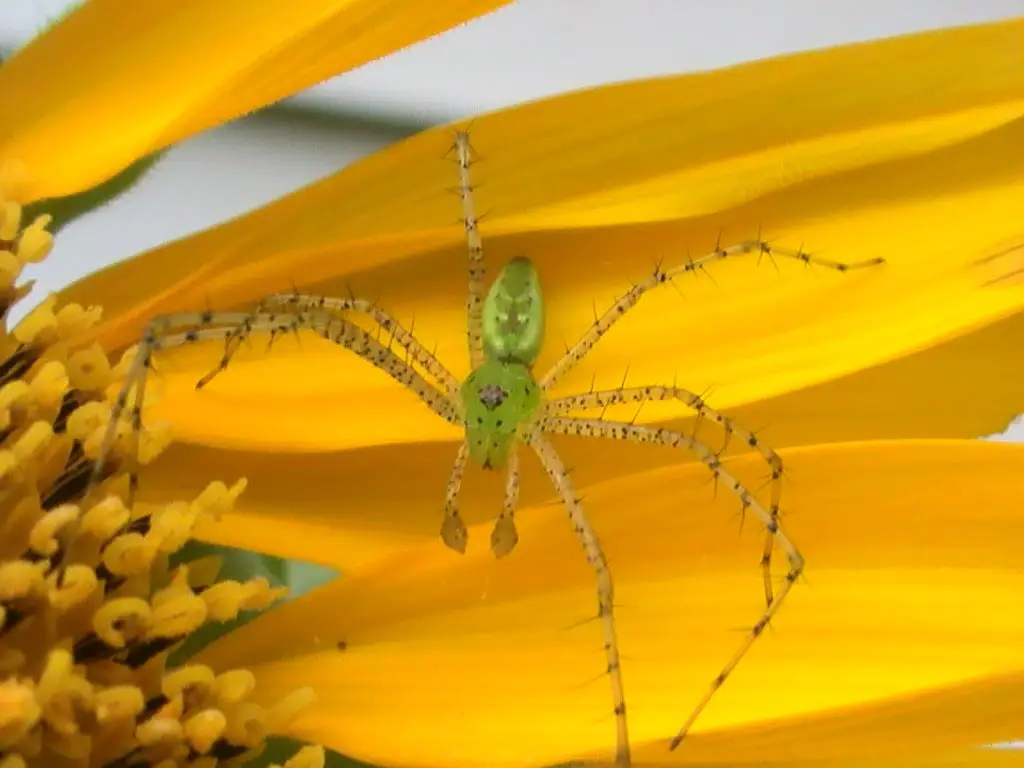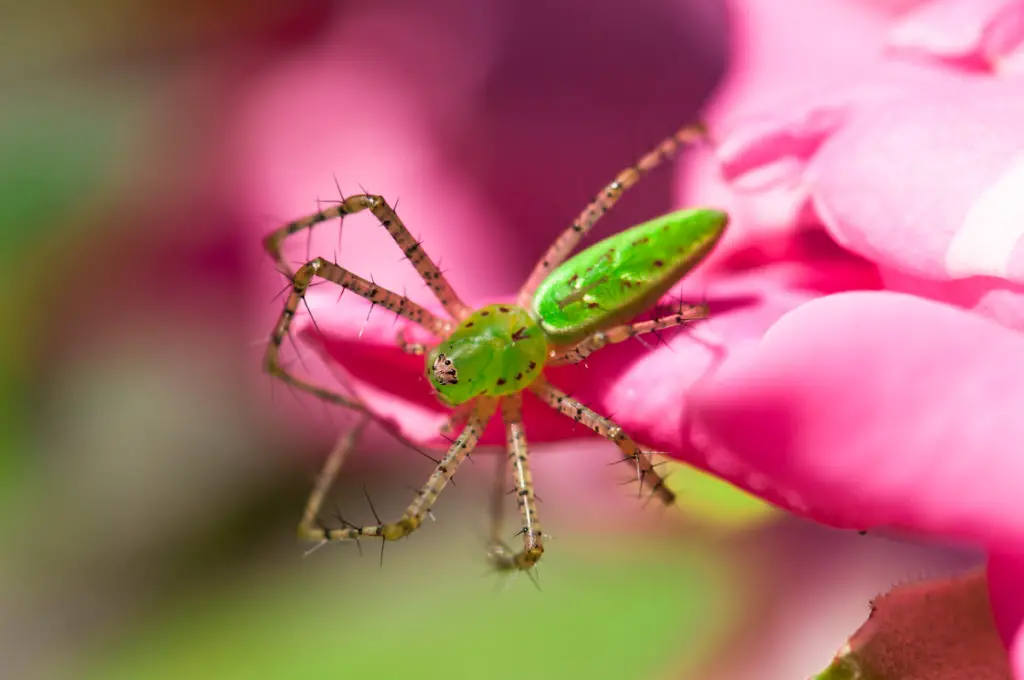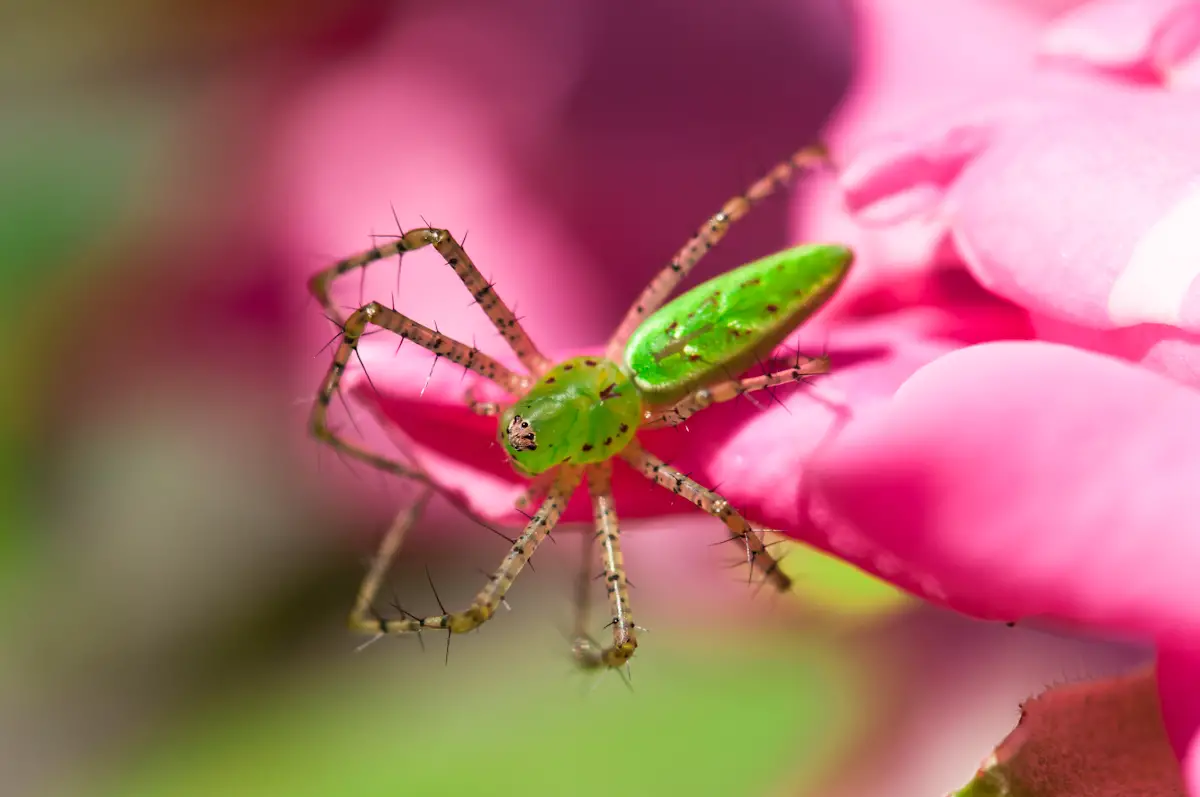Peucetia viridans, commonly known as the green lynx spider, is a large bright green spider found on many kinds of shrub-like plants throughout the southern United States. Outside the United States, they are also found in Mexico, Central America, and the West Indies.
Quick Overview: Peucetia viridans – Green Lynx Spider
Medically significant: No
Body size: 0.63”-0.47” (12 mm -16 mm)
Main colors: Green, Yellow
Range: Southern United States, Mexico, Central America, West Indie Islands
Web: No web
Green Lynx Spider Description
Green lynx spiders are medium-sized to large spiders with a bright green, or sometimes yellow, body. Their legs are long and appear almost translucent yellow or light green. The legs are covered with numerous thin black spines, or hairs.
The abdomen is usually green with lighter green, yellow or white chevron-shaped markings with six dark or red dots in the center. Often, these dots are only faintly visible or not visible at all.
Lynx spiders can be distinguished from other spider families by their individual hexagonal eye arrangements and the prominent spines on their legs. The green lynx spider is often confused with the magnolia green jumper (Lyssomanes viridis). If you notice black spines on the legs and if the legs are slightly differently colored than the body, you are most likely looking at a lynx spider.

Size
Females range up to 5/8 inches (22 mm) in body length, averaging approximately 0.63 inches (16 mm). Adult females can reach a total legspan of close to 3 inches (7 cm). Males are more slender and usually smaller than females, with an average body length of 0.47 inches (12 mm).

Web
Green lynx spiders don’t spin webs to catch prey. They do, however, use a silk dragline to catch and pull prey or other items from a distance.
Peucetia viridans spider bite
Although Green Lynx Spiders attack their insect prey aggressively, they rarely bite humans. Females have the ability and willingness to bite in defense, especially when guarding egg sacs. In the rare cases in which a bite occurs, they can be painful and cause strong local swelling and some local pain. The symptoms will generally wear off fairly quickly after the bite and medical attention is not necessary, unless severe physical or allergic reactions were to show. The green lynx spider is not a medically significant spider.
Peucetia viridans spider Scientific Classification
- Kingdom: Animalia
- Phylum: Arthropoda
- Subphylum: Chelicerata
- Class: Arachnida
- Order: Araneae
- Infraorder: Araneomorphae
- Family: Oxyopidae
- Genus: Peucetia
- Species: Peucetia viridans
Distribution of the green lynx spider in the USA
The green lynx spider prefers a warm climate and most sightings occur in the Southern United States from coast to coast. It is especially common in California and Florida. On the East Coast, the green lynx spider is found as far north as New York. Sightings of the green lynx spider have been reported from the following states:
Alabama, Arizona, Arkansas, California, Delaware, Florida, Georgia, Louisiana, Maryland, Mississippi, New Mexico, New Jersey, New York, North Carolina, Oklahoma, South Carolina , Tennessee, Texas , Virginia,
Alabama, Arizona, Arkansas, California, Delaware, Florida, Georgia, Louisiana, Maryland, Mississippi, New Jersey, New Mexico, New York, North Carolina, Oklahoma, South Carolina, Tennessee, Texas, Virginia and West Virginia.


Found on fence in Fort Worth Texas. About 2 inches long. Thanks for any help with ID.
Hello Jim, thanks for getting in touch! This is a green lynx spider (Peucetia viridans): https://bugguide.net/node/view/2032
They are not medically significant.
Not sure still
Found this one on a passion fruit plant in Tulsa area.
A Green Lynx photographed on my back wall 06sep24. I had no idea as to what it was until I found this site. To be honest, I was initially a bit afraid of the possibility of being bitten and stayed somewhat away from it, but took the photo anyway.